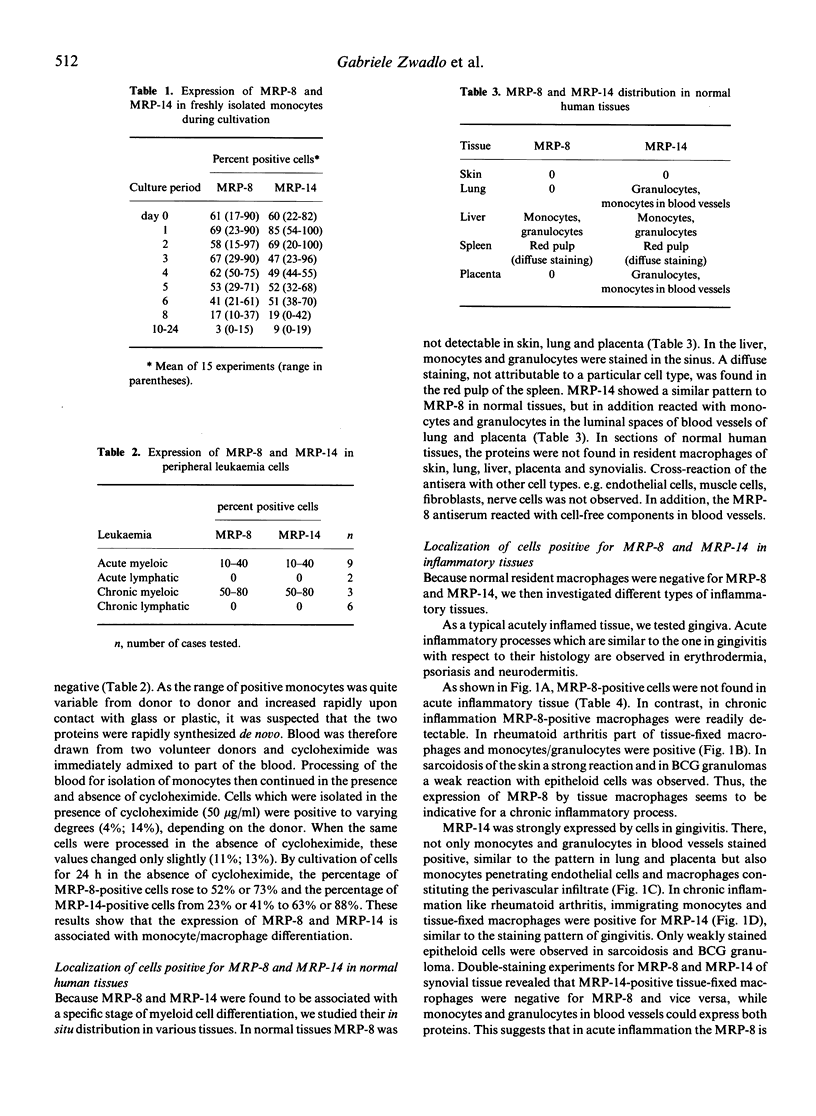Abstract
Using a monoclonal antibody to macrophage migration inhibition factor (MIF), two proteins were isolated from supernatants of Concanavalin A-stimulated human peripheral blood mononuclear cells which seem to have complexed to a third component carrying the MIF activity. They are therefore designated MIF-related proteins or MRP-8 and MRP-14 according to their apparent molecular weights. Partial amino acid sequences have been determined and their cDNA have been cloned and expressed in Escherichia coli. Both are calcium-binding proteins and MRP-8 seems to be largely homologous to the cystic fibrosis antigen (Dorin et al., 1987). Antisera were raised in the rabbit against the recombinant proteins and their expression in cells and tissues studied using immunohistological techniques. The proteins are only found in blood granulocytes and monocytes. In culture the number of positive monocytes sharply increased and then declined with time, suggesting that their expression is associated with early stages of monocyte/macrophage differentiation and absent from resident macrophages in all tested tissues. In acute inflammatory reactions, e.g. gingivitis, MRP-8 is never seen in the tissue, whereas MRP-14 is expressed by intravascular monocytes and perivascular macrophages. In contrast, in chronic inflammation, e.g. rheumatoid arthritis, MRP-8 is also expressed by macrophages in the tissue. From this it is concluded that MRP-8 and MRP-14 are expressed sequentially at defined stages of monocyte/macrophage differentiation and that dysregulation of this process in chronic inflammation is mirrored by the presence of MRP-8-positive macrophages in the tissue.
Full text
PDF





Images in this article
Selected References
These references are in PubMed. This may not be the complete list of references from this article.
- Burmeister G., Tarcsay L., Sorg C. Generation and characterization of a monoclonal antibody (1C5) to human migration inhibitory factor (MIF). Immunobiology. 1986 Jul;171(4-5):461–474. doi: 10.1016/S0171-2985(86)80077-8. [DOI] [PubMed] [Google Scholar]
- Dorin J. R., Novak M., Hill R. E., Brock D. J., Secher D. S., van Heyningen V. A clue to the basic defect in cystic fibrosis from cloning the CF antigen gene. Nature. 1987 Apr 9;326(6113):614–617. doi: 10.1038/326614a0. [DOI] [PubMed] [Google Scholar]
- Feige U., Overwien B., Sorg C. Purification of human blood monocytes by hypotonic density gradient centrifugation in Percoll. J Immunol Methods. 1982 Nov 12;54(3):309–315. doi: 10.1016/0022-1759(82)90315-5. [DOI] [PubMed] [Google Scholar]
- Feige U., Sorg C. Collection of large quantities of mononuclear cells from individual donors by continuous flow centrifugation leukapheresis. J Immunol Methods. 1984 Jan 20;66(1):161–170. doi: 10.1016/0022-1759(84)90258-8. [DOI] [PubMed] [Google Scholar]
- Hartung H. P. Acetyl glyceryl ether phosphorylcholine (platelet-activating factor) mediates heightened metabolic activity in macrophages. Studies on PGE, TXB2 and O2- production, spreading, and the influence of calmodulin-inhibitor W-7. FEBS Lett. 1983 Aug 22;160(1-2):209–212. doi: 10.1016/0014-5793(83)80968-5. [DOI] [PubMed] [Google Scholar]
- KAPLOW L. S. SIMPLIFIED MYELOPEROXIDASE STAIN USING BENZIDINE DIHYDROCHLORIDE. Blood. 1965 Aug;26:215–219. [PubMed] [Google Scholar]
- Malorny U., Knop J., Burmeister G., Sorg C. Immunohistochemical demonstration of migration inhibitory factor (MIF) in experimental allergic contact dermatitis. Clin Exp Immunol. 1988 Jan;71(1):164–170. [PMC free article] [PubMed] [Google Scholar]
- Neumann C., Sorg C. Sequential expression of functions during macrophage differentiation in murine bone marrow liquid cultures. Eur J Immunol. 1980 Nov;10(11):834–840. doi: 10.1002/eji.1830101107. [DOI] [PubMed] [Google Scholar]
- Odink K., Cerletti N., Brüggen J., Clerc R. G., Tarcsay L., Zwadlo G., Gerhards G., Schlegel R., Sorg C. Two calcium-binding proteins in infiltrate macrophages of rheumatoid arthritis. Nature. 1987 Nov 5;330(6143):80–82. doi: 10.1038/330080a0. [DOI] [PubMed] [Google Scholar]
- Schmalzl F., Braunsteiner H. Cytochemische Darstellung von Esteraseaktivitäten in Blut- und Knochenmarkszellen. Klin Wochenschr. 1968 Jun 15;46(12):642–650. doi: 10.1007/BF01727733. [DOI] [PubMed] [Google Scholar]
- Takenawa T., Homma Y., Nagai Y. Effect of calmodulin antagonists on lysosomal enzyme secretion and phospholipid metabolism in guinea-pig macrophages. Biochem J. 1982 Dec 15;208(3):549–558. doi: 10.1042/bj2080549. [DOI] [PMC free article] [PubMed] [Google Scholar]
- Wright B., Zeidman I., Greig R., Poste G. Inhibition of macrophage activation by calcium channel blockers and calmodulin antagonists. Cell Immunol. 1985 Oct 1;95(1):46–53. doi: 10.1016/0008-8749(85)90293-x. [DOI] [PubMed] [Google Scholar]
- Zwadlo G., Bröcker E. B., von Bassewitz D. B., Feige U., Sorg C. A monoclonal antibody to a differentiation antigen present on mature human macrophages and absent from monocytes. J Immunol. 1985 Mar;134(3):1487–1492. [PubMed] [Google Scholar]
- Zwadlo G., Schlegel R., Sorg C. A monoclonal antibody to a subset of human monocytes found only in the peripheral blood and inflammatory tissues. J Immunol. 1986 Jul 15;137(2):512–518. [PubMed] [Google Scholar]



